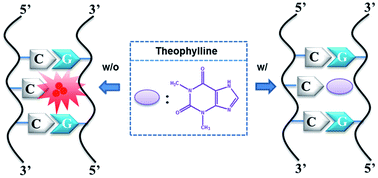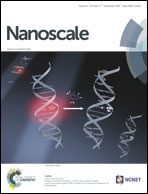Target-controlled formation of silver nanoclusters in abasic site-incorporated duplex DNA for label-free fluorescence detection of theophylline†
Abstract
A novel, label-free, fluorescence based sensor for theophylline has been developed. In the new sensor system, an abasic site-incorporated duplex DNA probe serves as both a pocket for recognition of theophylline and a template for the preparation of fluorescent silver nanoclusters. The strategy relies on theophylline-controlled formation of fluorescent silver nanoclusters from abasic site-incorporated duplex DNA. When theophylline is not present, silver ions interact with the cytosine groups opposite to the abasic site in duplex DNA. This interaction leads to efficient formation of intensely red fluorescent silver nanoclusters. In contrast, when theophylline is bound at the abasic site through pseudo base-pairing with appropriately positioned cytosines, silver ion binding to the cytosine nucleobase is prevented. Consequently, fluorescent silver nanoclusters are not formed causing a significant reduction of the fluorescence signal. By employing this new sensor, theophylline can be highly selectively detected at a concentration as low as 1.8 μM. Finally, the diagnostic capability and practical application of this sensor were demonstrated by its use in detecting theophylline in human blood serum.


 Please wait while we load your content...
Please wait while we load your content...